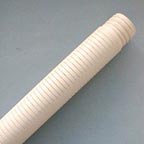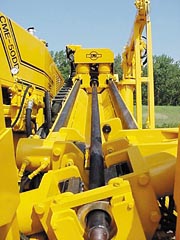
The function of the horizontal well and the installation technique will determine the type, diameter and screen design of well materials. A horizontal well placed in the saturated zone to extract ground water will have different design requirements than an unsaturated-zone well used for air extraction. Horizontal wells are similar to vertical wells in this respect.
Commonly used well materials for horizontal wells include high-density polyethylene (HDPE), polyvinyl chloride (PVC), steel and stainless steel. Well materials for horizontal wells must be flexible to withstand stresses during installation through the curved section of the borehole, and must be strong enough to withstand either tensile or compressive stresses induced during installation. These strength requirements are different from those for vertical well materials.
Materials installed in continuous boreholes typically undergo tensile stresses as the materials are installed by pulling back from the exit point to the entry point. On the other hand, materials installed in blind wells typically are pushed in from the entry point, thus undergoing compressive stresses during installation. A critical factor is the design of the joint connection, as that typically is the location where a failure may occur. Casing material manufacturers can provide information regarding the tensile and compressive strengths of their products in addition to the minimum radius of curvature requirements depending on the borehole diameter.
HDPE and fiberglass are extremely flexible materials that can be
installed through short radius of curvature boreholes. PVC, stainless steel and carbon steel can be used in medium or large radius of curvature boreholes. However, PVC actually is quite brittle; a number of casing failures have been documented using this material. Trend analysis shows that HDPE has become the material of choice for most environmental applications.
Fiberglass has been utilized in at least one instance where a requirement to withstand a high temperature was mandated. Stainless steel often is selected at sites where corrosive chemicals are known to exist in the subsurface. However, the higher cost of stainless steel limits its broad application.
A porous polyethylene pipe has recently been introduced into the market for horizontal well construction. Another company makes a louvered stainless steel screen that can be used as an alternative to costly pre-packed stainless steel screen. It has been successfully field tested for a horizontal environmental installation in California. A third company has developed a multi-layer composite stainless-steel screen for the petroleum industry that may be useful at some environmental sites.
Well materials should be selected for the specific well use(s). If filtration control is required, prepacked screens are highly recommended because placing a sand pack in a horizontal borehole is virtually impossible. There are methods of installing a filter pack in a horizontal well, but there is no guarantee that the filter pack will not bridge and leave a portion of the well screen without a filter pack. Well material manufacturers can supply pre-packed screens that meet any specifications. Pre-packed screens currently are available with stainless steel, HDPE and fiberglass well materials. However, the addition of a filter pack greatly increases the cost of the screen. Several other filtration control alternatives, such as filter socks and filter-mesh screens, have been manufactured and utilized to varying degrees of success.
Screen and slot parameters, as well as costs, will vary with material type. For example, HDPE screens typically are limited to a minimum slot size of 0.020 inches. Sophisticated screen designs have been developed, especially for horizontal air-sparging wells, to ensure air injection along the entire length of the screen. Modeling packages have been utilized to develop these sophisticated designs. Lengthwise slotting has been utilized for applications where greater tensile strength is required during installation.

Drilling Fluids
Drilling fluids typically are used to lubricate the bit and the drill pipe, to remove cuttings, and to control pressures in the subsurface. Different drilling methods use varying amounts of drilling fluids, which influence the target formation in different ways. The selection of an appropriate drilling fluid should consider the ultimate use of the well and the location of the well above or below the water table. Below the water table, well development can be conducted to remove drilling fluid from the borehole and from the formation in the vicinity of the borehole. Whereas, in the unsaturated zone above the water table, well development is difficult and, hence, drilling fluids should either be minimized or biodegradable drilling fluids may be utilized to maximize the performance of the well.Compaction drilling techniques, which require a minimum amount of drilling fluid, may be utilized at some sites but are limited greatly by the geology of the subsurface. In addition, the compaction technique reduces the permeability of the formation in the immediate vicinity of the borehole and complicates well development.
Some type of drilling fluid typically is utilized for installation of horizontal environmental wells. Important drilling-fluid characteristics include viscosity, gel strength, density and filtration. Drilling fluids are based on either bentonite clays or synthetic or natural polymers. Recent advances in drilling fluids that have been approved for environmental applications include bentonite fluids with mixed-metal hydroxides or silicates and advanced polymer systems. Some of the newer polymers have optimum cuttings carrying capacity and an ability to degrade naturally after drilling is completed (i.e., little well development is required).
Bentonite-based fluids commonly are used below the water table, where well development can ensure cleaning of the borehole. On the other hand, for wells installed above the water table (e.g., SVE wells), bio-based polymer fluids commonly are recommended.
Well Development
Well development is a critical step in the horizontal well installation process. The amount of time required to clean a well bore thoroughly may be much longer than that required to clean a vertical well. The total length of screen in the horizontal well oftentimes is orders of magnitude greater than that utilized in vertical wells. Physical and chemical methods of treatment usually are recommended to ensure successful development.
The specific well development plan must consider the type of drilling fluid, the well materials in the ground and the site geology. If a bentonite-based fluid was utilized for drilling, the development should be conducted as soon as possible after drilling is completed. Recommended actions may include acid wash, water flush, water jet, surge block/suction head and air lift/overpumping.
Survey Analysis
There has been a significant increase in the number of horizontal environmental wells installed annually in the United States since the first installations in the late 1980s. This increase reflects more widespread acceptance of the technology based on the technical advantages of horizontal wells and a lowering of costs for horizontal environmental well installations. The survey results have been analyzed by number of installations by year, well locations by state, remediation technique, site geology, depth of borehole, type of borehole and well materials. The following analysis shows how the industry has evolved since its inception in the late 1980s.Installations Per Year
Prior to 1990, very few installations (<5) occurred in any year. There was a dramatic increase in the number of wells installed from 1991 through 1996. After that time, there have been fewer wells installed each year, likely due to a tighter environmental remediation market.Well Locations
The state with the largest number of horizontal wells installed is Colorado at 255; more than 70 wells were installed at a single site. Other states with more than 30 wells installed include California, Washington, Michigan, New York, North Carolina, Ohio, Louisiana, Florida and Oklahoma. Each of these states has some type of horizontal well champion, either a drilling contractor, site owner or environmental consultant.Remediation Technique
Overall use can be categorized as 34 percent SVE, 28 percent GWE and free-product recovery, 21 percent AS, 5 percent bioremediation, 3 percent characterization and monitoring, and 9 percent hydraulic containment and other. More wells have been utilized for bioremediation and characterization/monitoring in the recent years, but the wells always have been utilized for a number of different environmental applications.
Well Depth and Type
Recent survey results indicate the same trend in well depth that was noted in a 1993 survey. Most wells still are installed at relatively shallow depths (<26 feet) by utility contractors. In 1996, 73 percent of the wells were installed at 25 feet or less vertical depth. As of 2000, this percentage increased to 83 percent. Further developments in the directional drilling industry have not moved the applications to greater depths. This may be due partly to the fact that the contamination at most sites is present at shallow depths, but may also be related to the higher costs for drilling at greater depths limiting the application of this technology, and may also reflect changing conditions in the environmental remediation market.
The deepest well remains that installed at Williams Air Force Base in Arizona at 235 feet below ground surface. Sixty percent of the wells are installed as continuous boreholes, while 40 percent are installed as blind boreholes. This percentage has not changed significantly over the last five years.
Report Abusive Comment